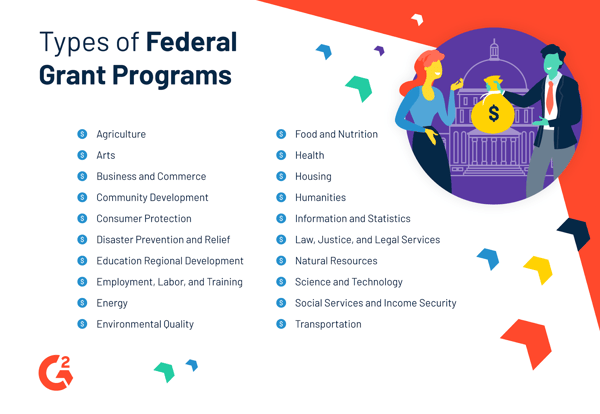
If you’re looking to fund your next big venture, you might find some luck in applying for grant money.
But before you dive headfirst into applying for grants, there’s a lot you’ll need to know. Grant money isn’t free money. It takes a lot of time to apply for a grant, and there are plenty of ways you can go wrong in the process. This guide will give you an overview of what grants are, how to apply for them, and how to write a grant proposal. Let’s dive in.
|
If you’re looking for specific information about grants, use the links below to jump ahead: |
In general terms, a grant is a financial reward given to a qualified recipient and is designated for a specific purpose. While most commonly associated with nonprofit organizations, there are actually a variety of grants available to organizations, researchers, and individual applicants.
No, grants are different than scholarships in that in most cases, you do not have to pay grant money back after it is awarded. They are also different from fellowships, which are usually awarded to individuals seeking to study a specific post-graduate academic interest.
Many grant programs are run by private foundations which means they are allowed to set different requirements than government grant programs. The most important thing to know about grants is that anyone can apply for a grant so long as they meet the eligibility requirements.
| Tip: Learn more about the differences between grants, scholarships, and fellowship programs. |
As we’ve mentioned, there are many different types of grants. The first step in applying for a grant is ensuring you’re applying for the right kind. The grants highlighted below cover the range of grants available to everyone from individuals to entire governments.
|
Already know what you’re looking for? Use the links below to jump ahead: |
A federal grant is awarded by a government agency with the purpose of carrying out a specific public purpose or initiative. There are three main types of federal grants.
Categorical grants may only be spent on a narrowly defined and previously established purpose. In most cases, recipients are required to match-up at least a portion of the money they receive. A common example of categorical grants are money issues through federal aid dollars in the event of natural disasters or catastrophes. Funds issued for medical research can also fall under this category.
Block grants are large funds distributed from the federal government to state or local governments. These grants are a form of social welfare and are often used to fund local law enforcement, community development, healthcare services, and more.
Earmark grants are used specifically as appropriations of the U.S. Congress. This type of grant is controversial because they are not competitively awarded and there is no formal process for a competitive or merit-based allocation process.

For the most part, federal grants are designed for large scale projects that have some sort of governmental affiliation. These are the types of projects that, when funded, impact entire communities or the country at large.
A private grant is a grant that is distributed from a foundation, corporation, or a non-government agency. Because these organizations are not burdened by the same compliance laws as government organizations, private grants can be easier to get than federal grants.
It’s important to note that these organizations are allowed to create their own criteria for their grant making process and there is no uniform application or requirement process. For this reason, you should do extensive research for every private grant you apply for beforehand.
A public charity grant can be awarded to any qualifying organization that has an 501(c)(3) designation from the IRS. A public charity grant can come from individuals, federal grants, private foundations, corporations, and more.
The common theme is that these grants are designed specifically for organizations that are legally tax-exempt by the IRS for projects that support the greater good. Oftentimes, they are granted to fund a specific program or initiative the charity is spearheading.
|
If you’re a nonprofit looking to apply for grants, learn how grant management software can make your life easier. |
As the name implies, an individual grant is a grant you apply to receive and fulfill on your own and not on behalf of an organization. These are more commonly referred to as fellowships or personal scholarship opportunities.
The MacArthur Fellows Program, also known as the MacArthur Genius Grant, is a perfect example of an individual grant process. Ultimately, these programs are designed by grant makers to fulfill whichever purpose they deem noble and worthy.
A nonprofit grant is different from a public charity grant in that you don’t have to be a 501(c)(3) to apply for one, the project you’re working on must simply benefit a charity.
An example might be if your business has a charitable arm or official charity like an annual scholarship program, your company could apply for a nonprofit grant to benefit your scholarship program, despite your company not being a nonprofit.
Once you’ve pinpointed the type of grant you want to apply for you can begin the process of applying for a grant. Depending on the type of grant you apply for the grant process can take anywhere from a couple of weeks to several months.
It can be tempting to start applying for grants right away but you’ll end up doing yourself more harm than good if your organization isn’t grant ready. Remember, you’re not just competing with yourself for these funds, you’re competing with other applicants as well.
|
Here’s a quick rundown of what your organization needs to be grant ready:
|
It’s always best to front load your work so that the application process goes as smoothly as possible. You want to provide grant makers as much information as you can up front so that there are fewer questions later. Once you’ve ticked all these boxes, you’re ready to move onto the next step.
Once you’ve found the grant you want to apply to, you can begin writing your proposal. It’s important to review the requirements and deadlines for the grant. Even the smallest missed detail could cost you funding.
Your grant proposal should cover the who, what, how, and why of your proposed project. Quantify as much as you can by showing the number of people your program serves set alongside how many people your program can help if you receive aid.
|
Here are some things to include when writing a grant proposal:
|
Your grant proposal will also need to show where the money will be going. You can do this by providing a sample budget of how you plan to use each and every dollar of the grant money if you were to receive it.
| Tip: Many companies employ the help of a grant writer for this process |
Depending on the type of grant you apply for, you might be asked to complete a certain type of grant proposal. Below is a rundown of the three most common types of grant proposals. It’s important to note that you should always check with the grant makers about what grant proposal format they expect you to use.
A letter of inquiry should be used in the case of applying for a private grant through a foundation. This type of grant proposal serves as a sort of cover letter in that it provides a high-level, two to three page review of the project you’re hoping to get funded.
Think of a letter of inquiry as a pre-grant application. This type of grant proposal allows for funders to narrow the field before digging into the deeper the details. It saves you and the grant makers time on putting together a full grant proposal.
This is the most common type of grant proposal and requires the most information about your project. A full grant proposal can range in length from anywhere from a handful of pages to 30 pages, so give yourself plenty of time to complete your proposal before the deadline.
Review the requirements set by the grant maker and ensure you have each part collected in the correct order. A full grant proposal often requires the help of multiple teams and stakeholders, so collaboration is key.
Most people assume a letter proposal is the easiest grant to write, but in many ways, it can be the trickiest. A letter proposal is a single-page summary for why you should receive funding. The challenge comes in being able to communicate everything you’d like to in a handful of pages.
Your letter proposal is not the same as a letter of inquiry or a statement of need. This is a full proposal presented in a condensed form.
The grant process is not something you can set and forget. Many grants cycle through several rounds of review before the final decision-making process. Oftentimes, grant makers will reach out to your organization for clarification or additional information.
In most cases, additional questions mean you’re still being considered! Use these follow-up questions as your opportunity to showcase your program. Give as much information as possible and be very careful to return the required information in a timely manner.
Grant money is not free money, and as with most things, there is a catch. The good news is that you don’t have to pay back your grant money with funds, rather by showing the results the money had on your program. This can be done through what is known as a grant report.
A grant report is a post-program write-up that you use to show the impact funding has had on your program. Think of a grant report like a book report. The purpose of a grant report is to show the people who invested in your program that the money they gave you was put to good use. This helps your organization build trust with grant makers and credibility as an organization.
|
What’s included in a grant report?
|
Many grants allow for multi-year applications for the same program, and if you’re hoping to snag a second or third round of funding, a killer grant report can seal the deal. They can also help you secure more funding from other grant applications processes. A grant report shows that your program is a good investment and impacts real people, through real results.
The hardest part of applying for grants is getting started. Once you have a few applications under your belt, you’ll learn the best ways to streamline your process and make your organization shine among the rest!
Ready to put everything you’ve learned into action? Here’s everything you need to know about writing a grant proposal.
Lauren Pope is a former content marketer at G2. You can find her work featured on CNBC, Yahoo! Finance, the G2 Learning Hub, and other sites. In her free time, Lauren enjoys watching true crime shows and singing karaoke. (she/her/hers)
Have you ever wanted to combine your love of writing with your passion for philanthropy?
 by Lauren Pope
by Lauren Pope
Nonprofits? Charities? What’s the difference?
 by Lauren Pope
by Lauren Pope
The world of nonprofits can be a confusing place for anyone not familiar with the terminology.
 by Lauren Pope
by Lauren Pope
Have you ever wanted to combine your love of writing with your passion for philanthropy?
 by Lauren Pope
by Lauren Pope
Nonprofits? Charities? What’s the difference?
 by Lauren Pope
by Lauren Pope


